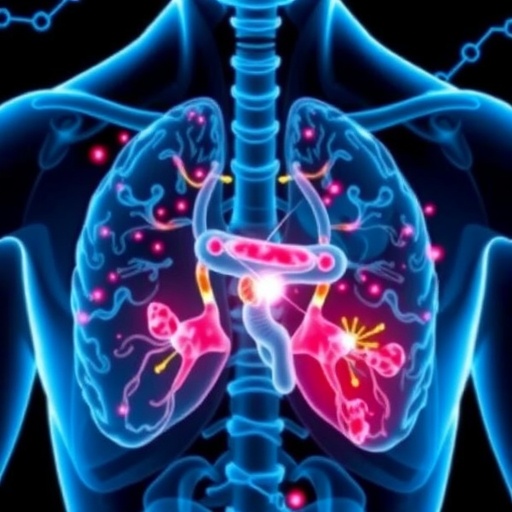The intricate ecosystem of microorganisms that inhabit the human skin, known as the skin microbiota, has been increasingly recognized for its critical role in maintaining overall skin health. This vast array of diverse microbes, including bacteria, viruses, and fungi, not only contributes to skin homeostasis but also acts as a frontline defense against pathogenic organisms. Among these microbial residents, certain bacteria have captivated scientific interest due to their ability to produce substances known as bacteriocins—ribosomal peptides that exhibit powerful antimicrobial properties. Recent research has embarked on a groundbreaking quest to uncover bacteriocins from the microbial genomes populating the sebaceous region of the skin, with the potential to illuminate novel therapeutic avenues in the fight against antibiotic resistance.
In light of the escalating threat posed by antibiotic-resistant bacteria, the need for innovative solutions has never been more pressing. The discovery and development of new antibiotics is a complex and often unsatisfying endeavor. Yet, nature has equipped us with a treasure trove of antimicrobial compounds produced by microbes. This study harnesses advanced computational tools for genome analysis, elevating the search for effective bacteriocins derived from our own microbiota to a cutting-edge scientific frontier. By employing a systematic bioinformatics approach, researchers identified an array of potential bacteriocin genes, operons, open reading frames (ORFs), and promoter regions that are tightly linked to bacteriocin biosynthesis.
The significance of this research extends beyond basic science; it embodies a powerful strategy to leverage our natural microbiota for therapeutic purposes. The core of this innovative research employed the BAGEL4 platform, a sophisticated bioinformatics tool renowned for its capability to detect structural bacteriocin genes within genomic sequences. By parsing through the genomic data of skin-dwelling microbes, the researchers could pinpoint the genetic architecture underpinning bacteriocin production. This step is crucial as it enables the identification of microbes with the intrinsic capability to serve as pharmaceutical agents, thereby reducing our dependence on conventional antibiotics.
However, the study did not stop at merely identifying potential gene candidates. It further integrated analytical methodologies to model bacterial growth and bacteriocin expression in response to varying environmental conditions. Utilizing MATLAB’s SimBiology application, the researchers simulated different growth parameters, thereby elucidating the optimal conditions for bacteriocin production. This modeling is vital because the efficacy of bacteriocins can be influenced significantly by factors such as nutrient availability, pH levels, and temperature. Hence, understanding these parameters can pave the way for maximizing the production yields of these valuable antimicrobial agents.
The implications of the findings are profound. The research demonstrates that the skin microbiota is not just a passive player in cutaneous health; it is an active producer of antimicrobial compounds that could serve as a formidable weapon against prevalent pathogens. By identifying promising bacteriocin candidates, this study lays the groundwork for future experimental validations and potential clinical applications. The outlook is optimistic, suggesting that these newly discovered agents could supplement or even replace traditional antibiotics, marking a significant step forward in combating the growing threat of antimicrobial resistance.
In the context of the rising tide of infections that are increasingly untreatable with existing antibiotics, the urgent need for alternatives cannot be overstated. This research sheds light on a vital pathway for the discovery of such alternatives, emphasizing the importance of the human microbiome. By harnessing the ecological wisdom inherent in our skin microbiota, we may very well have the opportunity to innovate new antibiotics that are not only effective but also derived from natural sources, thereby reducing the likelihood of adverse effects associated with synthetic drugs.
Furthermore, the study also opens up avenues for the integration of bacteriocins into probiotic formulations, potentially enhancing their efficacy in restoring and maintaining skin health. By exploring the dual role of these compounds as both antimicrobial agents and contributors to microbiome health, the research broadens the scope of bacteriocin applications beyond just infection control. This multifaceted approach signifies a shift towards a more holistic understanding of health, where microbial balance plays a pivotal role.
As we anticipate further exploration of these findings, the potential for clinical application invites excitement within the scientific community. The validation of these newly identified bacteriocins through experimental work could prove transformative not only for skin health but also for broader applications in wound care, dermatological treatments, and possibly even systemic infections. Continued interdisciplinary collaboration between microbiologists, bioinformaticians, and clinicians will be essential in translating these findings into practice.
The convergence of bioinformatics and microbiome research exemplifies a powerful approach to solving real-world health dilemmas. As researchers continue to mine the depths of the human microbiome, the promise of new therapeutic innovations from our microbial companions becomes ever more tangible. Each new discovery is a step closer to unraveling the complexities of microbial interactions and their profound implications for human health.
In conclusion, this pioneering research underscores the significance of the skin microbiota in the search for novel bacteriocins, serving as a crucial reminder of the untapped potential of our microscopic allies. As the scientific community moves forward, the integration of knowledge and technology offers a beacon of hope in the battle against antimicrobial resistance, making the exploration of our own microbiota a frontier for revolutionary medical advancements.
By revealing how common skin bacteria can be leveraged as sources for new antimicrobial agents, this research not only enriches our understanding of the microbiome but also provides a promising pathway to develop effective alternatives to conventional antibiotics. The future of bacteriocin research looks bright, with the potential to reshape modern medicine in ways that profoundly benefit public health.
Subject of Research: Discovery of bacteriocins from skin microbiota.
Article Title: Bioinformatics-driven discovery of skin microbiota bacteriocins as potential antibiotics and probiotics.
Article References:
Munir, A., Janbey, A., Sajjad, B. et al. Bioinformatics-driven discovery of skin microbiota bacteriocins as potential antibiotics and probiotics.
J Antibiot 78, 606–620 (2025). https://doi.org/10.1038/s41429-025-00847-2
Image Credits: AI Generated
DOI: September 2025
Keywords: Bacteriocins, skin microbiota, antimicrobial resistance, probiotics, bioinformatics.
Tags: antibiotic resistance solutionsantibiotics and probiotics in skin healthantimicrobial properties of bacteriocinsbioinformatics in microbiota studiescutting-edge research in skin healthgenome analysis for bacteriocinsinnovative antibiotic development strategiesmicrobial ecosystems and skin homeostasisnatural antimicrobial compounds from skin microbesrole of skin microbiome in immunityskin microbiota researchtherapeutic applications of skin microbiota






